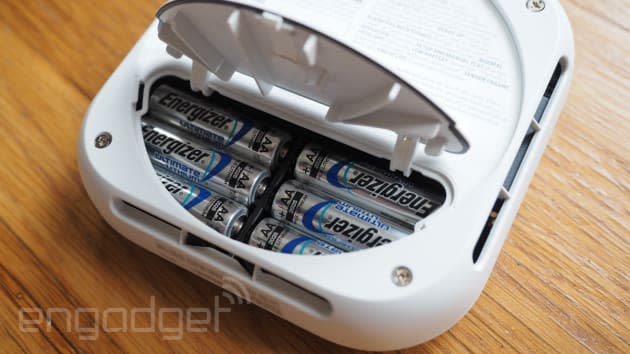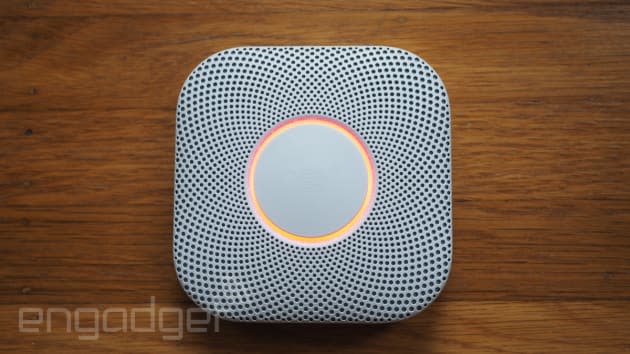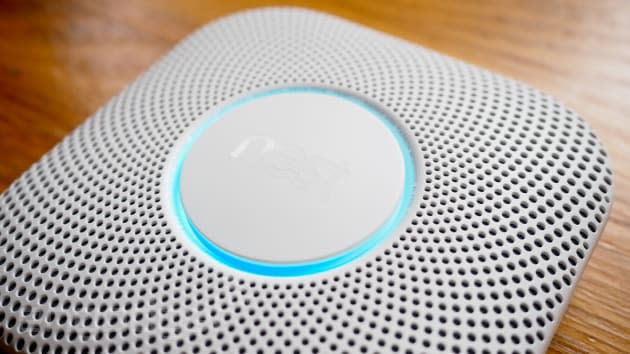Nest Protect review (2015): Improved safety makes it easier to recommend

There's nothing cool about safety. Yes, safety is important, but it's very rarely cool. The stylish Nest Protect is, at its core, a smoke detector -- the least chic item in your home. Still, when the company that brought us the smart thermostat introduced a smoke alarm, it stood out from its rivals with swanky features like lighting your way in the dark and a companion app. Those were and still are nice, but it's the safety features that make the device a worthy addition to the home. In particular, Nest recently updated the Protect with more precise air detection. This is a welcome turn after the company's wave-to-silence feature in the last model ended up accidentally silencing the device. That experiment in parlor tricks led Nest to halt sales of the Protect, only to put it back on the market with the motion-control feature disabled.
As before, the updated smoke/carbon monoxide detector uses a human voice to calmly warn you when the alarm is about to go off. Once again, too, the Protect reminds you that it's there thanks to a helpful night-light feature. At $99, it's more than double the price of other smoke alarms you'll find in your local hardware store. But, thanks to a companion app and its integration with the Nest Cam, Nest Thermostat and other Protects you may have installed, it's a solid investment for anyone who wants to constantly monitor their home, but more importantly, it's a safer solution than what you have on your ceiling right now.
Hardware

The Protect is a clean piece of hardware with a glowing light ring and lots of tiny holes throughout. Given the smoke detector's location near the ceiling, all that fancy design work would mostly go unnoticed until disaster struck or the battery needed changing. But that illuminated circle forces you to notice the Protect. When the lights are turned off, the ring glows green after running a quick diagnostic scan that Nest calls the "Nightly Promise." That nocturnal light show continues when the motion sensors detect movement, at which point a path light turns on and fades out as you walk away. I wake up a few times a night to check on my cat and the path light has quickly become my favorite feature.
Well, besides not letting me die in my sleep due to a fire or carbon monoxide leak.
Still, by becoming a motion-detecting night-light, the Protect reminds you that it's there. It demands you notice it. That's something most regular detectors fail to do. I realized how important this is at the beginning of my review when I found out that that my current detector had been off the entire six years I've lived in my apartment. The battery (which was installed backward) had an expiration date of March 2005. It's my fault for being neglectful. If you've also forgotten to check your smoke detector for the past six years, having a safety device in your home that occasionally tries to get your attention is a good idea.
Attention is nice, but it's the increased safety that's important. Specifically, the new Protect uses a split-spectrum sensor with a second blue LED for enhanced monitoring of the air entering the device. The additional light given off by the blue LED helps the detector to see more and determine if a particle is cause for alarm. The technology that measures all this stuff is housed in a stainless steel case that keeps dust and fibers out while letting smoke enter. According to Nest, this leads to fewer false alarms. Indeed, during my tests, it ignored steam from my nearby bathroom -- a clear step up from the smoke detector at my old apartment, which would routinely flag steam as smoke and emit an ear-splitting alarm as I was getting ready for work. That might be why my current smoke alarm was deactivated: It's right in front of my bathroom.
Setup

The Nest Protect is available in black or white and with two power options: wired and battery-powered (I tested the latter). Connecting the smoke detector to the Nest app requires scanning a QR code on the back of the device. After you've done that, pull a tab to turn it on, pair it with your phone and then select where it'll reside in your home (e.g., the kitchen). If you have multiple Nest Protects, the app will prompt you to add all of them. The idea is that if you have multiple smoke detectors in your home, they can connect to the same Nest Aware account and communicate via a mesh network called Nest Weave. Even if your home network is down, then, the devices will still be able to talk to each other.
No matter how many of these devices you buy, it shouldn't take long to install them on your ceiling. If you have a step stool and a screwdriver (or better, a drill), then setup is a breeze. After screwing in the mounting plate, just line up the detector with the bracket tabs and twist it on. Done. Nest Aware also makes onboarding simple by pairing the devices in the app using a QR code. Once everything is up and running, the detectors are controlled via a mobile app (for iOS and Android) or with an online portal.
And while Nest does a lot to make the installation process painless, I recommend hiring an electrician if you decide to get the wired version. That is, unless you're the type of person who routinely swaps out appliances and knows where your breaker box is and what it does.
In use

Nest sent along some fake smoke to test the Protect. It's the same canned spray that arrived with the original Nest for its review. To my disappointment, it doesn't actually spew smoke, but it does trick your smoke detector into thinking that you are in peril. After a few very quick sprays at the device, it went from, "Hey, there might be something wrong," to, "OMG! We're all gonna die!"
Well, maybe not that. In reality, a female voice says to you, "Heads up. There's smoke in the living room. The alarm may sound." Then, if the problem gets worse: "Emergency! There's smoke in the living room!" Both of these are preceded and followed by alarms: a quieter one for the warning and an ear-piercing tone for actual emergencies.
Before all hell breaks loose, while the Protect is in warning mode, hitting the large button on the device or using the app turns off the alarm. After some issues with a feature on the first-generation Protect that gave users the option of waving their hand to shut off the alarm, Nest removed it. The device was misinterpreting movements in the home as hand waves and disabling the initial warning. Not something you want happening during an emergency. But, you can still use the app to silence warnings if you're under six feet tall and don't want to keep a stepladder near your detectors. Once the Protect determines that the smoke or carbon monoxide level is at a dangerous level, you can't turn off the alarm until the perceived threat has cleared. This is a legal requirement to keep people from deactivating detectors and ignoring a potentially dangerous situation.
When the coast is clear, the alarm and the app tell you that the smoke has dissipated. In addition, the app will make note of the date and time of the incident so that if you're not at home, you can investigate what triggered the alerts. Even if you don't use the app on a daily basis, it's there when you want to find out what happened.
Software
If you've gone all in with the Nest products and have not just a smoke alarm, but also a Nest Thermostat and a Nest Cam, the Protect gets more useful thanks to the Nest Aware app. The Thermostat still turns off gas-powered devices (like furnaces) and the app continues to notify you when the Protect senses a problem. But the Nest Cam and Dropcam integration is new. When an alarm is triggered the cameras begin recording and the app sends out a notification that something is amiss. At which point, you can launch the application and see what's happening in real time. If you're out of the house, this information can be the difference between calling 911 and realizing that someone just overcooked a meal.

Because I only had one Protect, I was also unable to test its ability to talk to other Protects even if the WiFi in your home has failed. The Nest Weave feature uses onboard WiFi to keep them talking to one another and alerting you to a situation even when the power goes out. For example, if Protect detects a carbon monoxide leak in the family room and you can't hear the alarm from that room, the Protects in other parts of the house will be able to alert you.
If you have a large home, this feature could be super handy, but also costly when each device rings in at $99 a pop. Yes, it's pricey, but when your home network goes down and the detectors are still talking to one another because one of them has identified an actual hazard instead of steam, it's definitely worth it.
The competition
All you have to do is look up toward your ceiling to see what Nest is competing against. Most of the smoke detectors out there have been installed for years and replacing nearly all of them will cost you less than $50 apiece. They are cheaper, but once you start adding smart features, the price quickly climbs. One of those sub-$50 devices is the sort-of-smart Kidde 2-in-1 Wireless Alarm. It works with the Wink app and hub and features voice alarms, detects smoke and carbon monoxide and runs on a mesh network. But, it requires a separate device, the $50 Wink Hub, to take advantage of those more advanced features. The combined price puts it on par with the Protect, but without the convenience of having all this functionality packed into a single device.
The rest of the smoke and carbon monoxide detector market (both wired and battery-powered) are smoke/carbon monoxide updates of the tried-and-true smoke detectors. Some, like the $43 First Alert Talking Combination Smoke and Carbon Monoxide Alarm have -- as the rather long name implies -- a voice feature. But none have the entire "smart" package of the Protect.
Wrap-up

Compared to the average smoke detector, the Nest Protect seems like an extravagance. It's more than double the price of a garden-variety device and although it's pretty, it's also something you'll rarely look at. But, when you're thinking about safety, it's a little easier to justify the added cost, especially since the Protect is rated for 10 years of use, is more sensitive to dangerous elements while reducing false alarms and gives you gentle warnings before a situation really becomes unsafe. Many of the Protect's smart features carried over from the previous version, and that's great, but it's the internal safety upgrades that ultimately keep you safe. The Protect may look cool on the outside, but like we've learned from every after-school special, it's what's inside that counts.






